National Australia Bank: Customer Behaviour Situation Analysis Report
VerifiedAdded on 2021/12/04
|10
|1859
|64
Report
AI Summary
This report provides a comprehensive situational analysis of customer behavior within the National Australia Bank (NAB). It begins with an introduction highlighting the importance of understanding customer behavior for business success, especially in the dynamic banking sector. The report then delves into a situational analysis, emphasizing the need to assess internal and external factors. It explores the nature of the banking industry, market dynamics, and buyer behavior, including the impact of technological advancements. A consumer behavior matrix is presented, categorizing customers based on their involvement and confidence levels. The report examines NAB's products, services, and administrative aspects, including its focus on customer-centric operations and its diverse range of financial offerings. It also includes financial data from the Australian Prudential Regulation Authority (APRA). The target market for NAB is outlined, encompassing existing customers, students, and individuals seeking wealth management services. The report concludes by referencing relevant literature on customer behavior, marketing, and banking strategies to influence customer purchase decisions and brand loyalty.
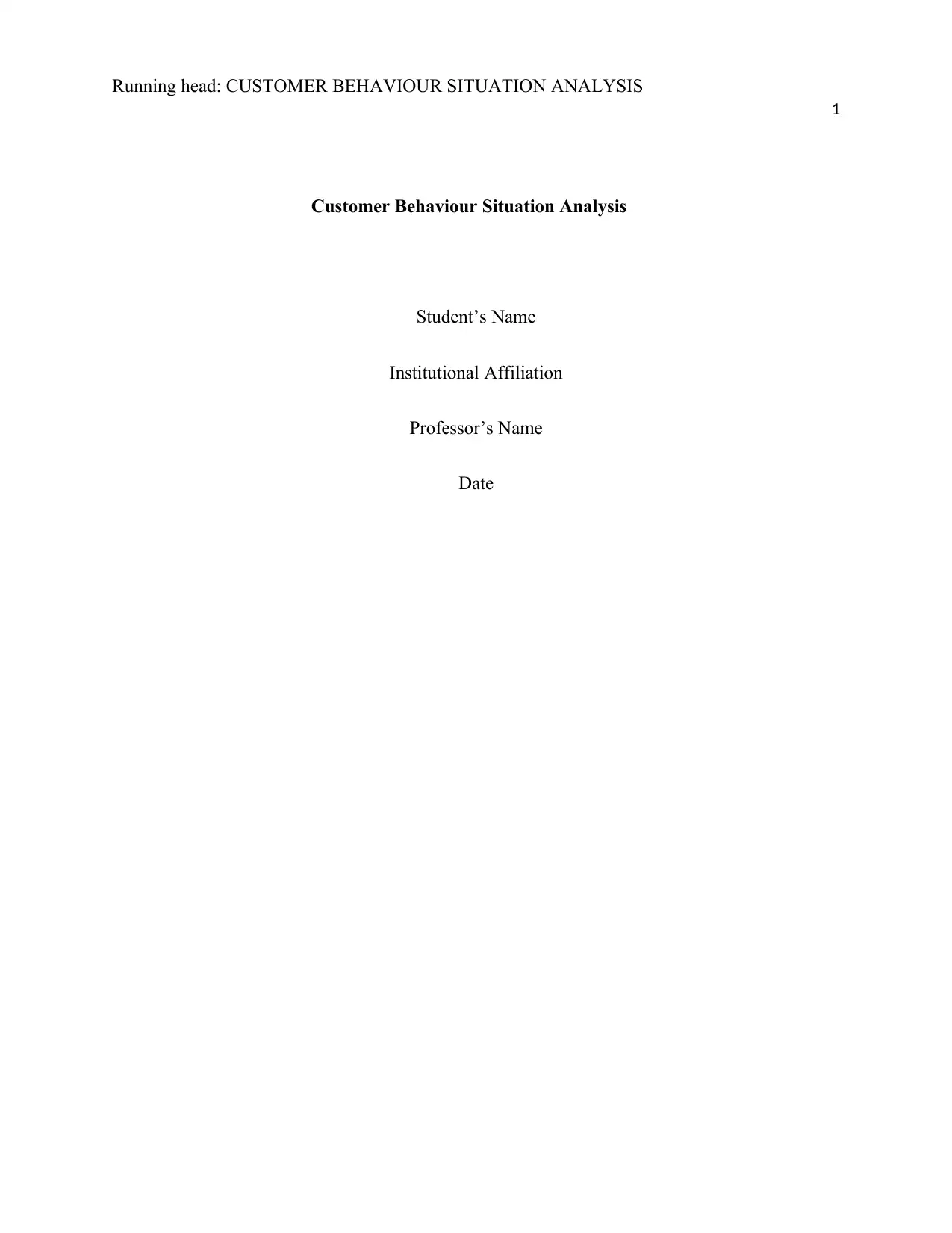
Running head: CUSTOMER BEHAVIOUR SITUATION ANALYSIS
1
Customer Behaviour Situation Analysis
Student’s Name
Institutional Affiliation
Professor’s Name
Date
1
Customer Behaviour Situation Analysis
Student’s Name
Institutional Affiliation
Professor’s Name
Date
Paraphrase This Document
Need a fresh take? Get an instant paraphrase of this document with our AI Paraphraser
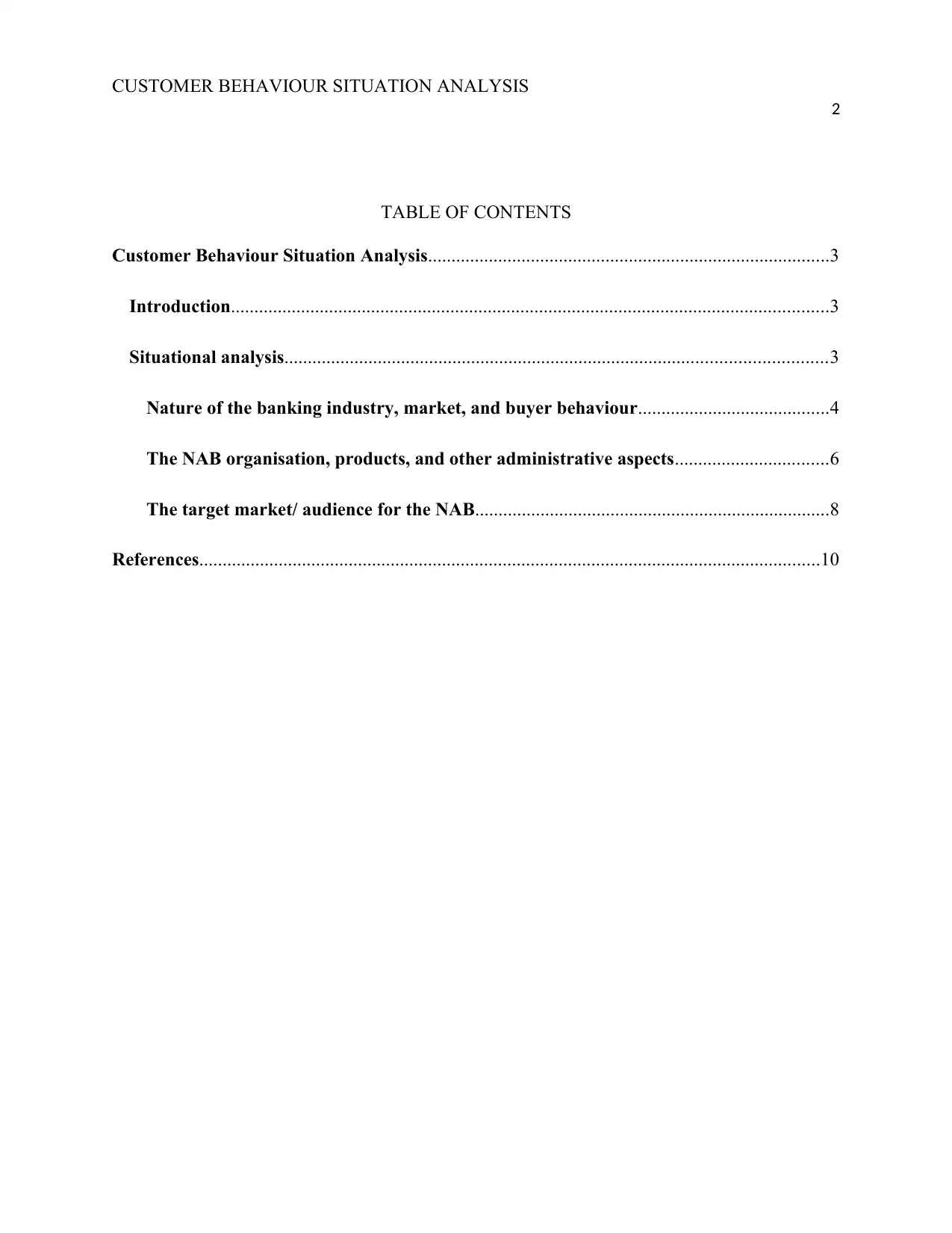
CUSTOMER BEHAVIOUR SITUATION ANALYSIS
2
TABLE OF CONTENTS
Customer Behaviour Situation Analysis......................................................................................3
Introduction................................................................................................................................3
Situational analysis....................................................................................................................3
Nature of the banking industry, market, and buyer behaviour.........................................4
The NAB organisation, products, and other administrative aspects.................................6
The target market/ audience for the NAB............................................................................8
References.....................................................................................................................................10
2
TABLE OF CONTENTS
Customer Behaviour Situation Analysis......................................................................................3
Introduction................................................................................................................................3
Situational analysis....................................................................................................................3
Nature of the banking industry, market, and buyer behaviour.........................................4
The NAB organisation, products, and other administrative aspects.................................6
The target market/ audience for the NAB............................................................................8
References.....................................................................................................................................10
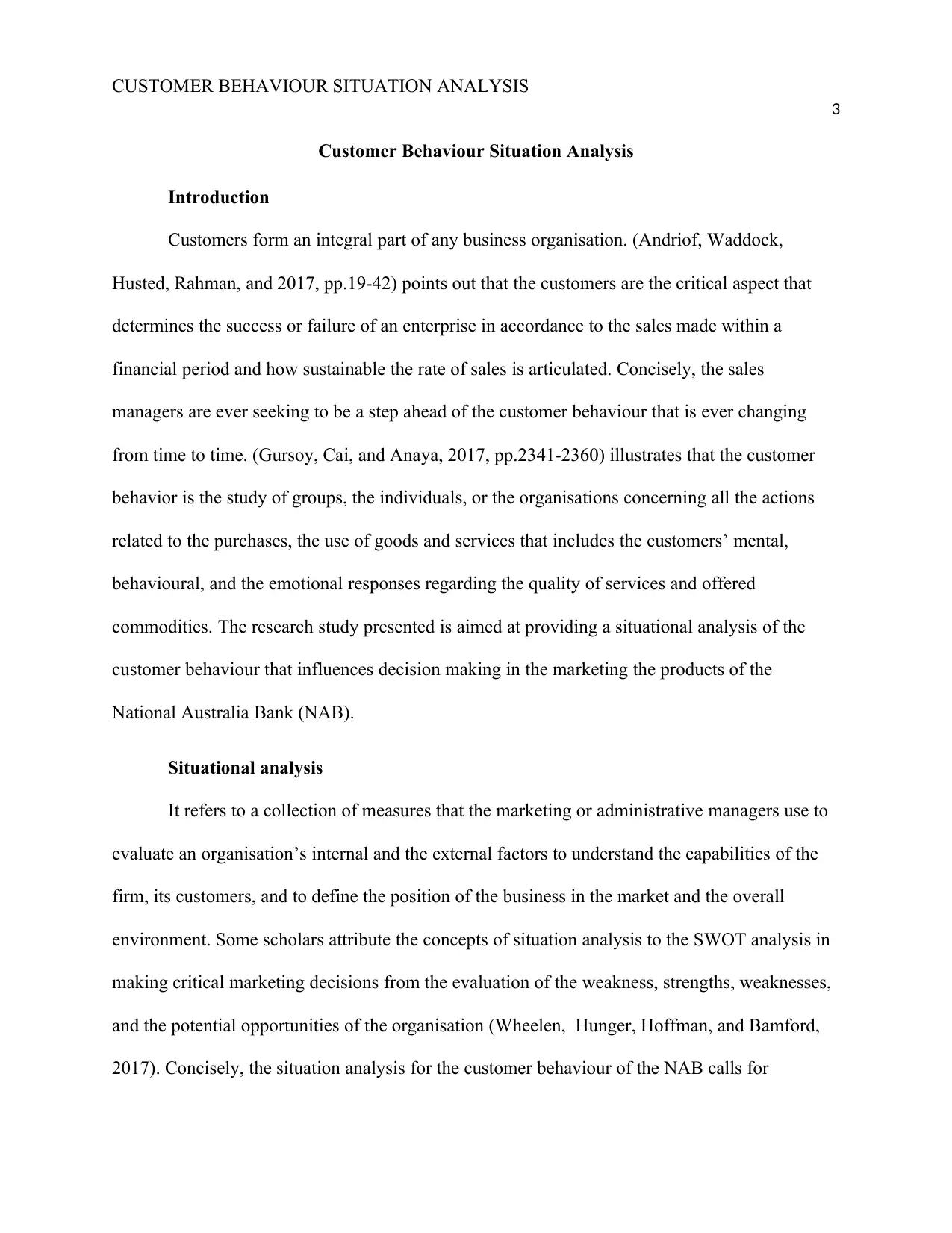
CUSTOMER BEHAVIOUR SITUATION ANALYSIS
3
Customer Behaviour Situation Analysis
Introduction
Customers form an integral part of any business organisation. (Andriof, Waddock,
Husted, Rahman, and 2017, pp.19-42) points out that the customers are the critical aspect that
determines the success or failure of an enterprise in accordance to the sales made within a
financial period and how sustainable the rate of sales is articulated. Concisely, the sales
managers are ever seeking to be a step ahead of the customer behaviour that is ever changing
from time to time. (Gursoy, Cai, and Anaya, 2017, pp.2341-2360) illustrates that the customer
behavior is the study of groups, the individuals, or the organisations concerning all the actions
related to the purchases, the use of goods and services that includes the customers’ mental,
behavioural, and the emotional responses regarding the quality of services and offered
commodities. The research study presented is aimed at providing a situational analysis of the
customer behaviour that influences decision making in the marketing the products of the
National Australia Bank (NAB).
Situational analysis
It refers to a collection of measures that the marketing or administrative managers use to
evaluate an organisation’s internal and the external factors to understand the capabilities of the
firm, its customers, and to define the position of the business in the market and the overall
environment. Some scholars attribute the concepts of situation analysis to the SWOT analysis in
making critical marketing decisions from the evaluation of the weakness, strengths, weaknesses,
and the potential opportunities of the organisation (Wheelen, Hunger, Hoffman, and Bamford,
2017). Concisely, the situation analysis for the customer behaviour of the NAB calls for
3
Customer Behaviour Situation Analysis
Introduction
Customers form an integral part of any business organisation. (Andriof, Waddock,
Husted, Rahman, and 2017, pp.19-42) points out that the customers are the critical aspect that
determines the success or failure of an enterprise in accordance to the sales made within a
financial period and how sustainable the rate of sales is articulated. Concisely, the sales
managers are ever seeking to be a step ahead of the customer behaviour that is ever changing
from time to time. (Gursoy, Cai, and Anaya, 2017, pp.2341-2360) illustrates that the customer
behavior is the study of groups, the individuals, or the organisations concerning all the actions
related to the purchases, the use of goods and services that includes the customers’ mental,
behavioural, and the emotional responses regarding the quality of services and offered
commodities. The research study presented is aimed at providing a situational analysis of the
customer behaviour that influences decision making in the marketing the products of the
National Australia Bank (NAB).
Situational analysis
It refers to a collection of measures that the marketing or administrative managers use to
evaluate an organisation’s internal and the external factors to understand the capabilities of the
firm, its customers, and to define the position of the business in the market and the overall
environment. Some scholars attribute the concepts of situation analysis to the SWOT analysis in
making critical marketing decisions from the evaluation of the weakness, strengths, weaknesses,
and the potential opportunities of the organisation (Wheelen, Hunger, Hoffman, and Bamford,
2017). Concisely, the situation analysis for the customer behaviour of the NAB calls for
⊘ This is a preview!⊘
Do you want full access?
Subscribe today to unlock all pages.

Trusted by 1+ million students worldwide
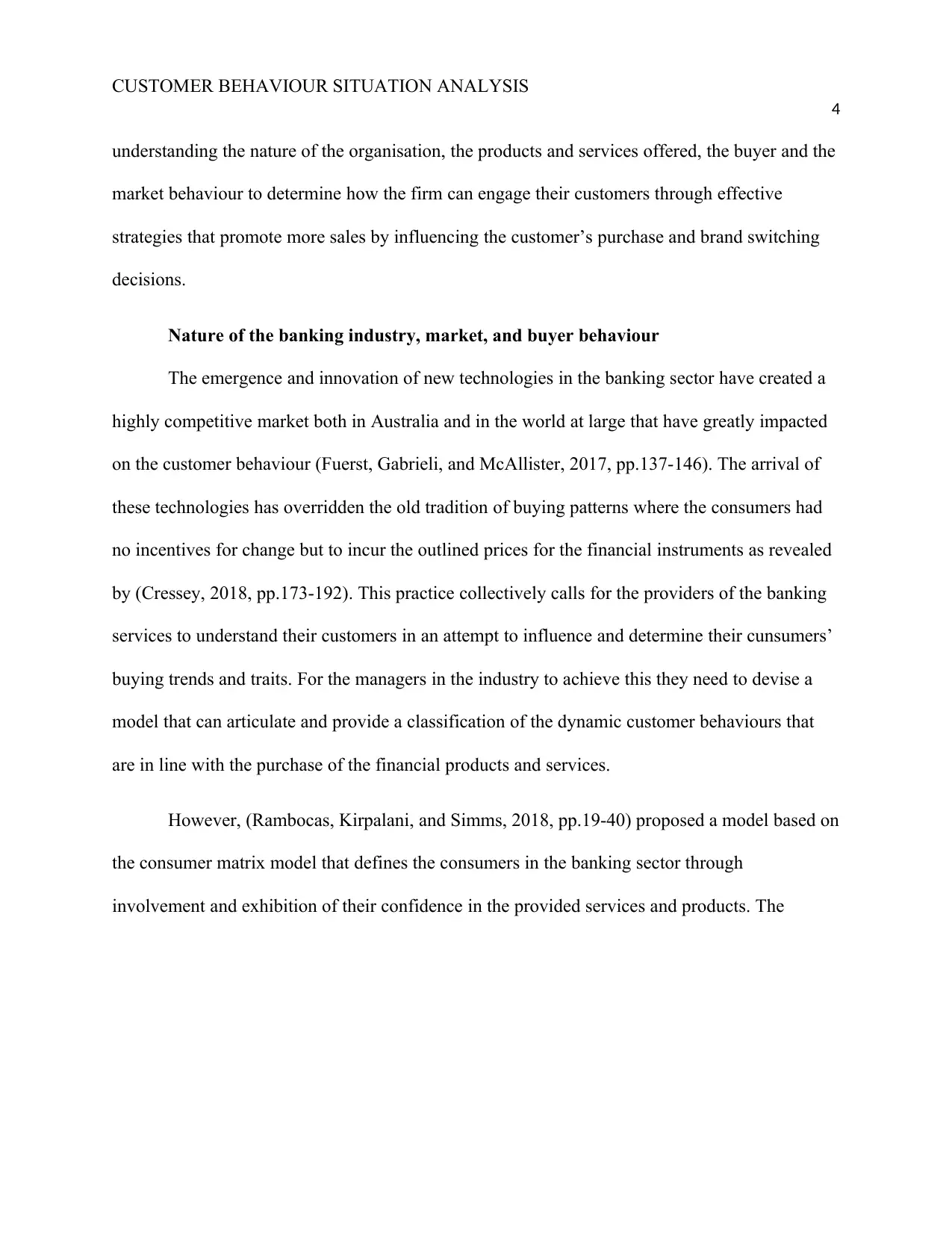
CUSTOMER BEHAVIOUR SITUATION ANALYSIS
4
understanding the nature of the organisation, the products and services offered, the buyer and the
market behaviour to determine how the firm can engage their customers through effective
strategies that promote more sales by influencing the customer’s purchase and brand switching
decisions.
Nature of the banking industry, market, and buyer behaviour
The emergence and innovation of new technologies in the banking sector have created a
highly competitive market both in Australia and in the world at large that have greatly impacted
on the customer behaviour (Fuerst, Gabrieli, and McAllister, 2017, pp.137-146). The arrival of
these technologies has overridden the old tradition of buying patterns where the consumers had
no incentives for change but to incur the outlined prices for the financial instruments as revealed
by (Cressey, 2018, pp.173-192). This practice collectively calls for the providers of the banking
services to understand their customers in an attempt to influence and determine their cunsumers’
buying trends and traits. For the managers in the industry to achieve this they need to devise a
model that can articulate and provide a classification of the dynamic customer behaviours that
are in line with the purchase of the financial products and services.
However, (Rambocas, Kirpalani, and Simms, 2018, pp.19-40) proposed a model based on
the consumer matrix model that defines the consumers in the banking sector through
involvement and exhibition of their confidence in the provided services and products. The
4
understanding the nature of the organisation, the products and services offered, the buyer and the
market behaviour to determine how the firm can engage their customers through effective
strategies that promote more sales by influencing the customer’s purchase and brand switching
decisions.
Nature of the banking industry, market, and buyer behaviour
The emergence and innovation of new technologies in the banking sector have created a
highly competitive market both in Australia and in the world at large that have greatly impacted
on the customer behaviour (Fuerst, Gabrieli, and McAllister, 2017, pp.137-146). The arrival of
these technologies has overridden the old tradition of buying patterns where the consumers had
no incentives for change but to incur the outlined prices for the financial instruments as revealed
by (Cressey, 2018, pp.173-192). This practice collectively calls for the providers of the banking
services to understand their customers in an attempt to influence and determine their cunsumers’
buying trends and traits. For the managers in the industry to achieve this they need to devise a
model that can articulate and provide a classification of the dynamic customer behaviours that
are in line with the purchase of the financial products and services.
However, (Rambocas, Kirpalani, and Simms, 2018, pp.19-40) proposed a model based on
the consumer matrix model that defines the consumers in the banking sector through
involvement and exhibition of their confidence in the provided services and products. The
Paraphrase This Document
Need a fresh take? Get an instant paraphrase of this document with our AI Paraphraser
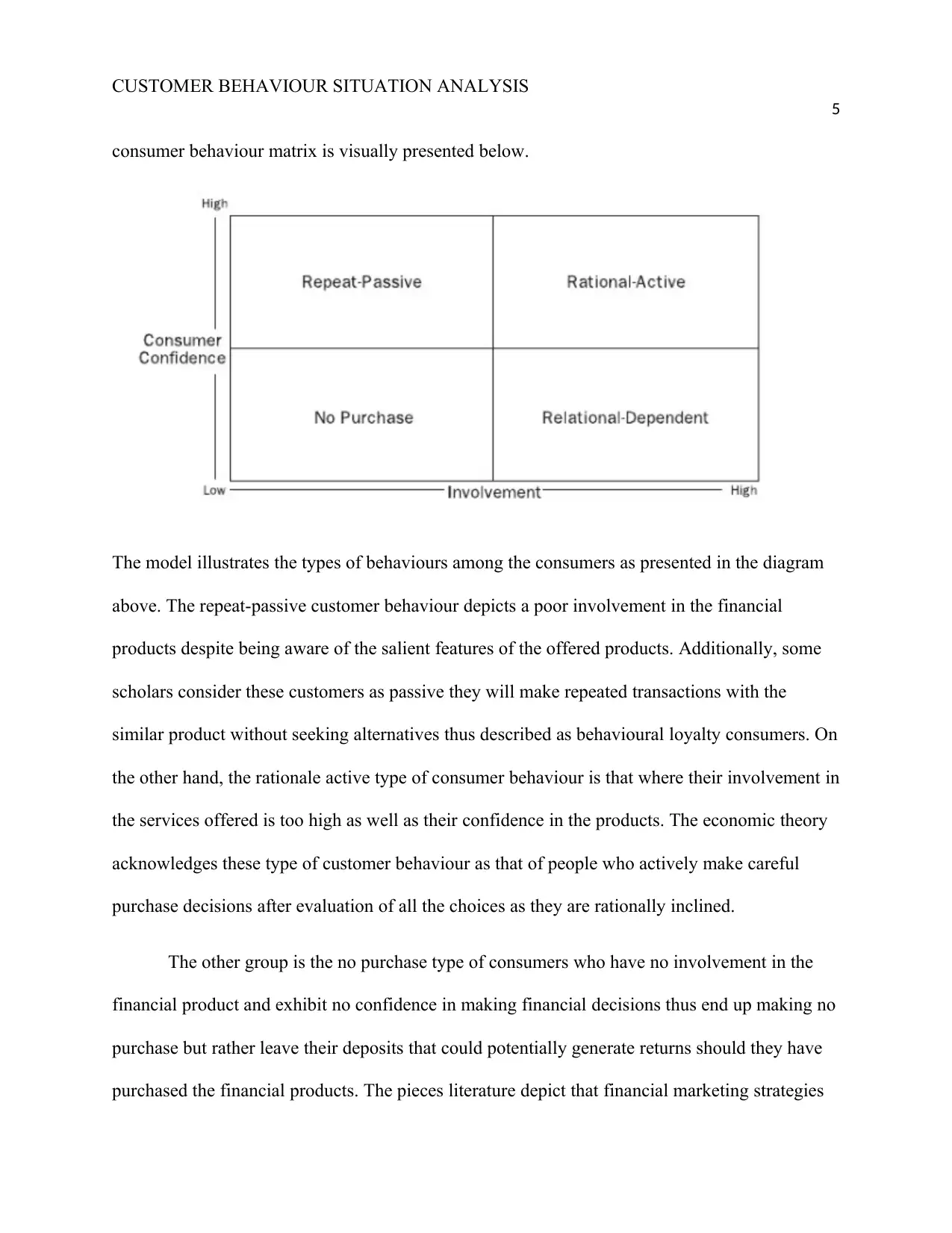
CUSTOMER BEHAVIOUR SITUATION ANALYSIS
5
consumer behaviour matrix is visually presented below.
The model illustrates the types of behaviours among the consumers as presented in the diagram
above. The repeat-passive customer behaviour depicts a poor involvement in the financial
products despite being aware of the salient features of the offered products. Additionally, some
scholars consider these customers as passive they will make repeated transactions with the
similar product without seeking alternatives thus described as behavioural loyalty consumers. On
the other hand, the rationale active type of consumer behaviour is that where their involvement in
the services offered is too high as well as their confidence in the products. The economic theory
acknowledges these type of customer behaviour as that of people who actively make careful
purchase decisions after evaluation of all the choices as they are rationally inclined.
The other group is the no purchase type of consumers who have no involvement in the
financial product and exhibit no confidence in making financial decisions thus end up making no
purchase but rather leave their deposits that could potentially generate returns should they have
purchased the financial products. The pieces literature depict that financial marketing strategies
5
consumer behaviour matrix is visually presented below.
The model illustrates the types of behaviours among the consumers as presented in the diagram
above. The repeat-passive customer behaviour depicts a poor involvement in the financial
products despite being aware of the salient features of the offered products. Additionally, some
scholars consider these customers as passive they will make repeated transactions with the
similar product without seeking alternatives thus described as behavioural loyalty consumers. On
the other hand, the rationale active type of consumer behaviour is that where their involvement in
the services offered is too high as well as their confidence in the products. The economic theory
acknowledges these type of customer behaviour as that of people who actively make careful
purchase decisions after evaluation of all the choices as they are rationally inclined.
The other group is the no purchase type of consumers who have no involvement in the
financial product and exhibit no confidence in making financial decisions thus end up making no
purchase but rather leave their deposits that could potentially generate returns should they have
purchased the financial products. The pieces literature depict that financial marketing strategies
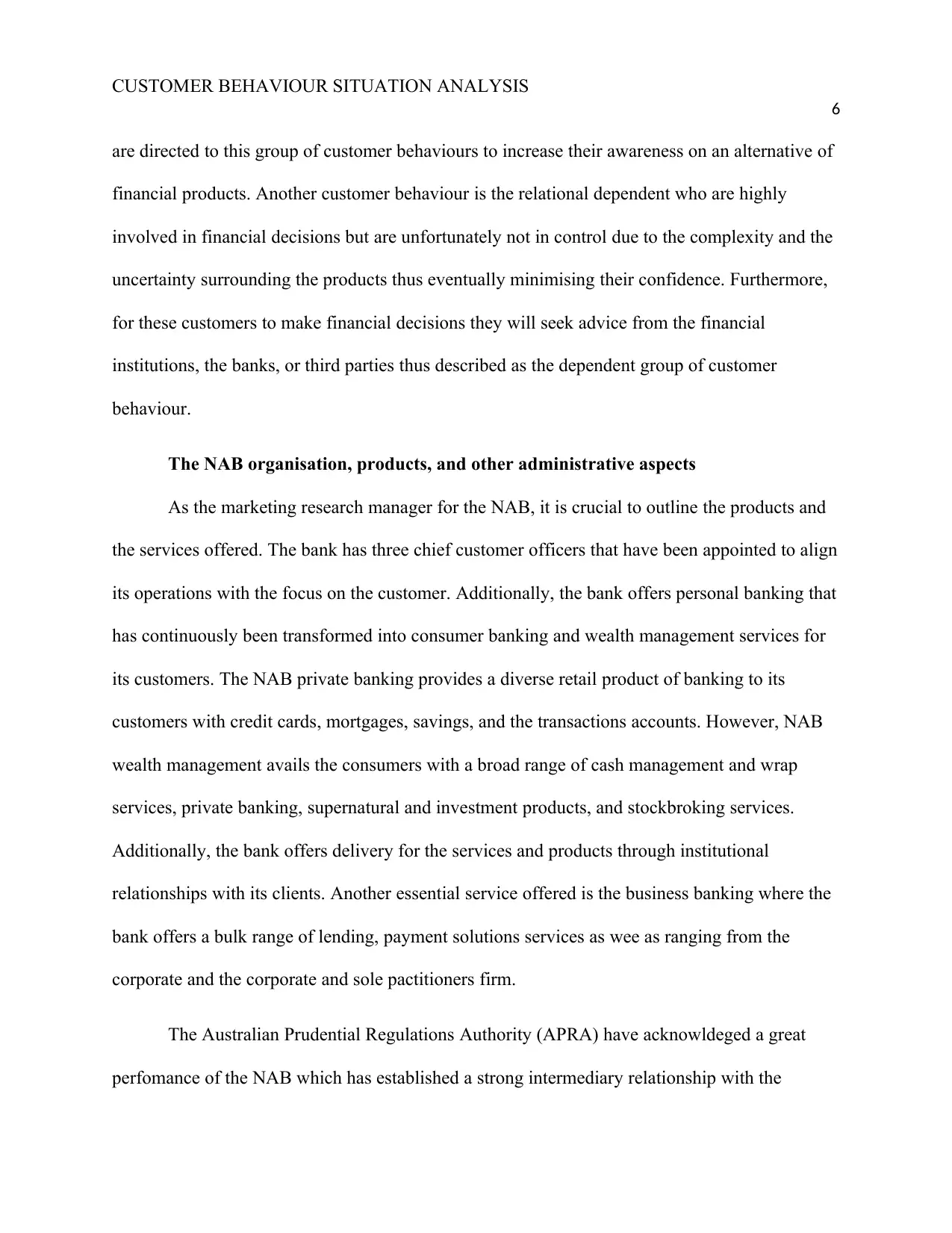
CUSTOMER BEHAVIOUR SITUATION ANALYSIS
6
are directed to this group of customer behaviours to increase their awareness on an alternative of
financial products. Another customer behaviour is the relational dependent who are highly
involved in financial decisions but are unfortunately not in control due to the complexity and the
uncertainty surrounding the products thus eventually minimising their confidence. Furthermore,
for these customers to make financial decisions they will seek advice from the financial
institutions, the banks, or third parties thus described as the dependent group of customer
behaviour.
The NAB organisation, products, and other administrative aspects
As the marketing research manager for the NAB, it is crucial to outline the products and
the services offered. The bank has three chief customer officers that have been appointed to align
its operations with the focus on the customer. Additionally, the bank offers personal banking that
has continuously been transformed into consumer banking and wealth management services for
its customers. The NAB private banking provides a diverse retail product of banking to its
customers with credit cards, mortgages, savings, and the transactions accounts. However, NAB
wealth management avails the consumers with a broad range of cash management and wrap
services, private banking, supernatural and investment products, and stockbroking services.
Additionally, the bank offers delivery for the services and products through institutional
relationships with its clients. Another essential service offered is the business banking where the
bank offers a bulk range of lending, payment solutions services as wee as ranging from the
corporate and the corporate and sole pactitioners firm.
The Australian Prudential Regulations Authority (APRA) have acknowldeged a great
perfomance of the NAB which has established a strong intermediary relationship with the
6
are directed to this group of customer behaviours to increase their awareness on an alternative of
financial products. Another customer behaviour is the relational dependent who are highly
involved in financial decisions but are unfortunately not in control due to the complexity and the
uncertainty surrounding the products thus eventually minimising their confidence. Furthermore,
for these customers to make financial decisions they will seek advice from the financial
institutions, the banks, or third parties thus described as the dependent group of customer
behaviour.
The NAB organisation, products, and other administrative aspects
As the marketing research manager for the NAB, it is crucial to outline the products and
the services offered. The bank has three chief customer officers that have been appointed to align
its operations with the focus on the customer. Additionally, the bank offers personal banking that
has continuously been transformed into consumer banking and wealth management services for
its customers. The NAB private banking provides a diverse retail product of banking to its
customers with credit cards, mortgages, savings, and the transactions accounts. However, NAB
wealth management avails the consumers with a broad range of cash management and wrap
services, private banking, supernatural and investment products, and stockbroking services.
Additionally, the bank offers delivery for the services and products through institutional
relationships with its clients. Another essential service offered is the business banking where the
bank offers a bulk range of lending, payment solutions services as wee as ranging from the
corporate and the corporate and sole pactitioners firm.
The Australian Prudential Regulations Authority (APRA) have acknowldeged a great
perfomance of the NAB which has established a strong intermediary relationship with the
⊘ This is a preview!⊘
Do you want full access?
Subscribe today to unlock all pages.

Trusted by 1+ million students worldwide
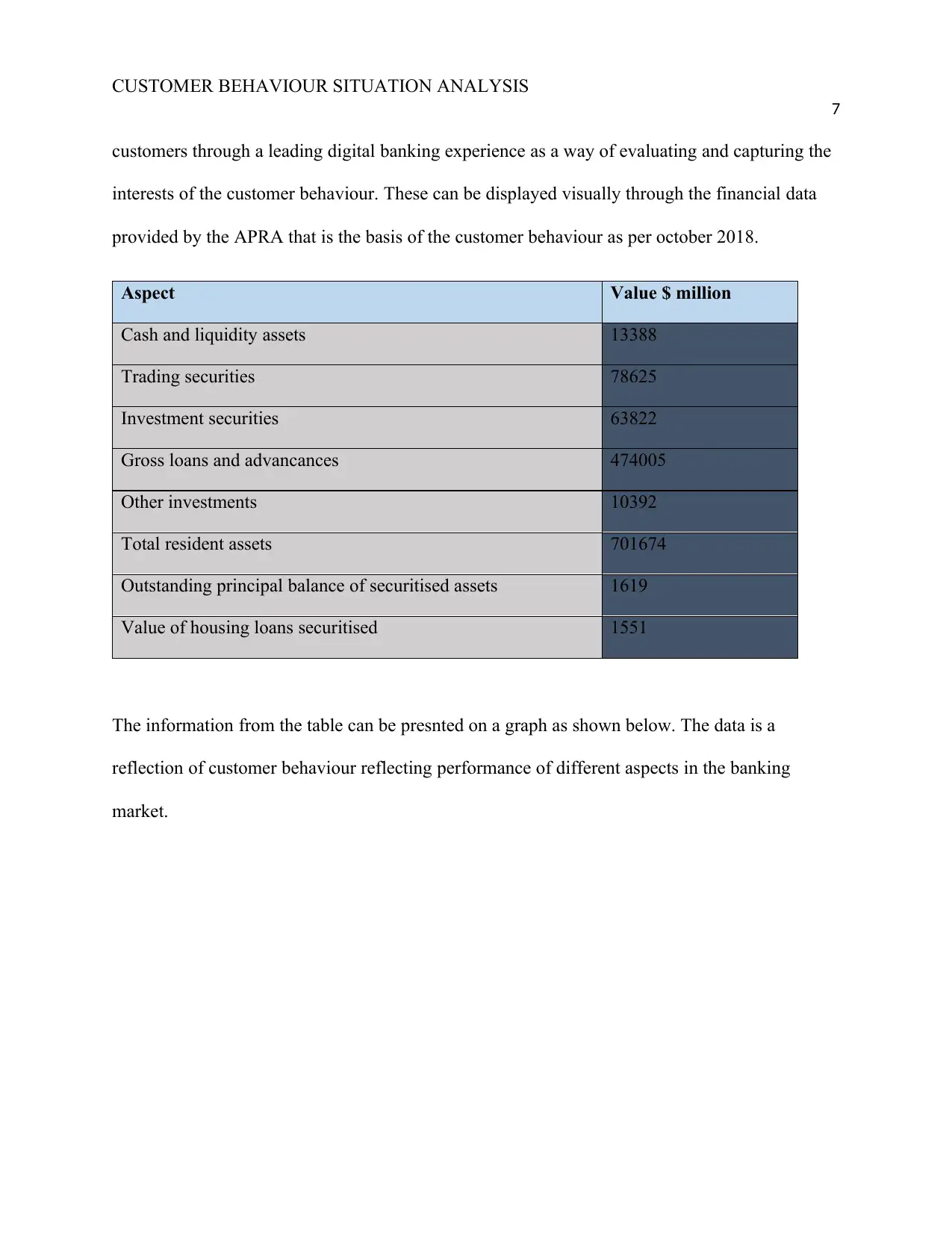
CUSTOMER BEHAVIOUR SITUATION ANALYSIS
7
customers through a leading digital banking experience as a way of evaluating and capturing the
interests of the customer behaviour. These can be displayed visually through the financial data
provided by the APRA that is the basis of the customer behaviour as per october 2018.
Aspect Value $ million
Cash and liquidity assets 13388
Trading securities 78625
Investment securities 63822
Gross loans and advancances 474005
Other investments 10392
Total resident assets 701674
Outstanding principal balance of securitised assets 1619
Value of housing loans securitised 1551
The information from the table can be presnted on a graph as shown below. The data is a
reflection of customer behaviour reflecting performance of different aspects in the banking
market.
7
customers through a leading digital banking experience as a way of evaluating and capturing the
interests of the customer behaviour. These can be displayed visually through the financial data
provided by the APRA that is the basis of the customer behaviour as per october 2018.
Aspect Value $ million
Cash and liquidity assets 13388
Trading securities 78625
Investment securities 63822
Gross loans and advancances 474005
Other investments 10392
Total resident assets 701674
Outstanding principal balance of securitised assets 1619
Value of housing loans securitised 1551
The information from the table can be presnted on a graph as shown below. The data is a
reflection of customer behaviour reflecting performance of different aspects in the banking
market.
Paraphrase This Document
Need a fresh take? Get an instant paraphrase of this document with our AI Paraphraser
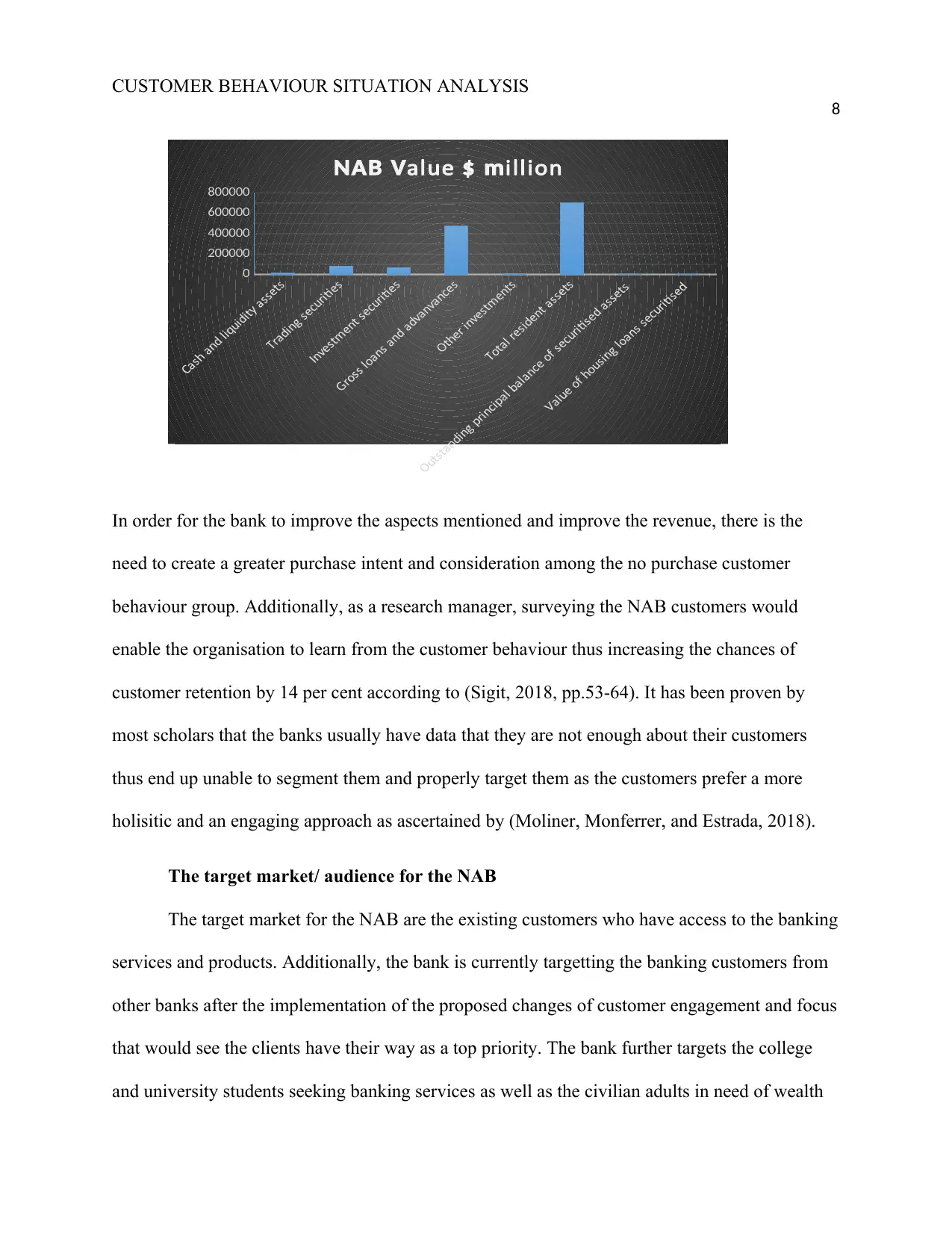
CUSTOMER BEHAVIOUR SITUATION ANALYSIS
8
0
200000
400000
600000
800000
alue illionNAB V $ m
In order for the bank to improve the aspects mentioned and improve the revenue, there is the
need to create a greater purchase intent and consideration among the no purchase customer
behaviour group. Additionally, as a research manager, surveying the NAB customers would
enable the organisation to learn from the customer behaviour thus increasing the chances of
customer retention by 14 per cent according to (Sigit, 2018, pp.53-64). It has been proven by
most scholars that the banks usually have data that they are not enough about their customers
thus end up unable to segment them and properly target them as the customers prefer a more
holisitic and an engaging approach as ascertained by (Moliner, Monferrer, and Estrada, 2018).
The target market/ audience for the NAB
The target market for the NAB are the existing customers who have access to the banking
services and products. Additionally, the bank is currently targetting the banking customers from
other banks after the implementation of the proposed changes of customer engagement and focus
that would see the clients have their way as a top priority. The bank further targets the college
and university students seeking banking services as well as the civilian adults in need of wealth
8
0
200000
400000
600000
800000
alue illionNAB V $ m
In order for the bank to improve the aspects mentioned and improve the revenue, there is the
need to create a greater purchase intent and consideration among the no purchase customer
behaviour group. Additionally, as a research manager, surveying the NAB customers would
enable the organisation to learn from the customer behaviour thus increasing the chances of
customer retention by 14 per cent according to (Sigit, 2018, pp.53-64). It has been proven by
most scholars that the banks usually have data that they are not enough about their customers
thus end up unable to segment them and properly target them as the customers prefer a more
holisitic and an engaging approach as ascertained by (Moliner, Monferrer, and Estrada, 2018).
The target market/ audience for the NAB
The target market for the NAB are the existing customers who have access to the banking
services and products. Additionally, the bank is currently targetting the banking customers from
other banks after the implementation of the proposed changes of customer engagement and focus
that would see the clients have their way as a top priority. The bank further targets the college
and university students seeking banking services as well as the civilian adults in need of wealth
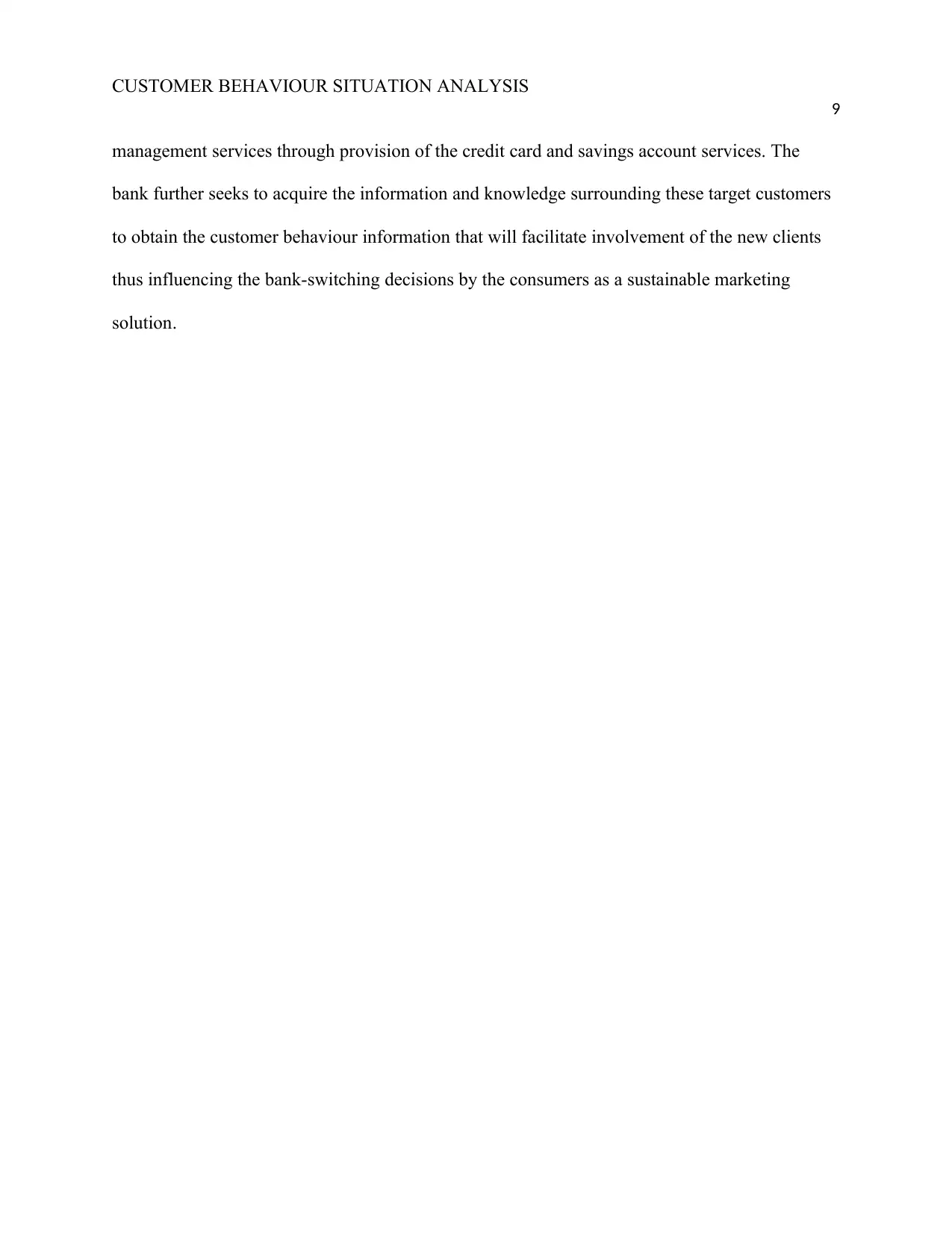
CUSTOMER BEHAVIOUR SITUATION ANALYSIS
9
management services through provision of the credit card and savings account services. The
bank further seeks to acquire the information and knowledge surrounding these target customers
to obtain the customer behaviour information that will facilitate involvement of the new clients
thus influencing the bank-switching decisions by the consumers as a sustainable marketing
solution.
9
management services through provision of the credit card and savings account services. The
bank further seeks to acquire the information and knowledge surrounding these target customers
to obtain the customer behaviour information that will facilitate involvement of the new clients
thus influencing the bank-switching decisions by the consumers as a sustainable marketing
solution.
⊘ This is a preview!⊘
Do you want full access?
Subscribe today to unlock all pages.

Trusted by 1+ million students worldwide
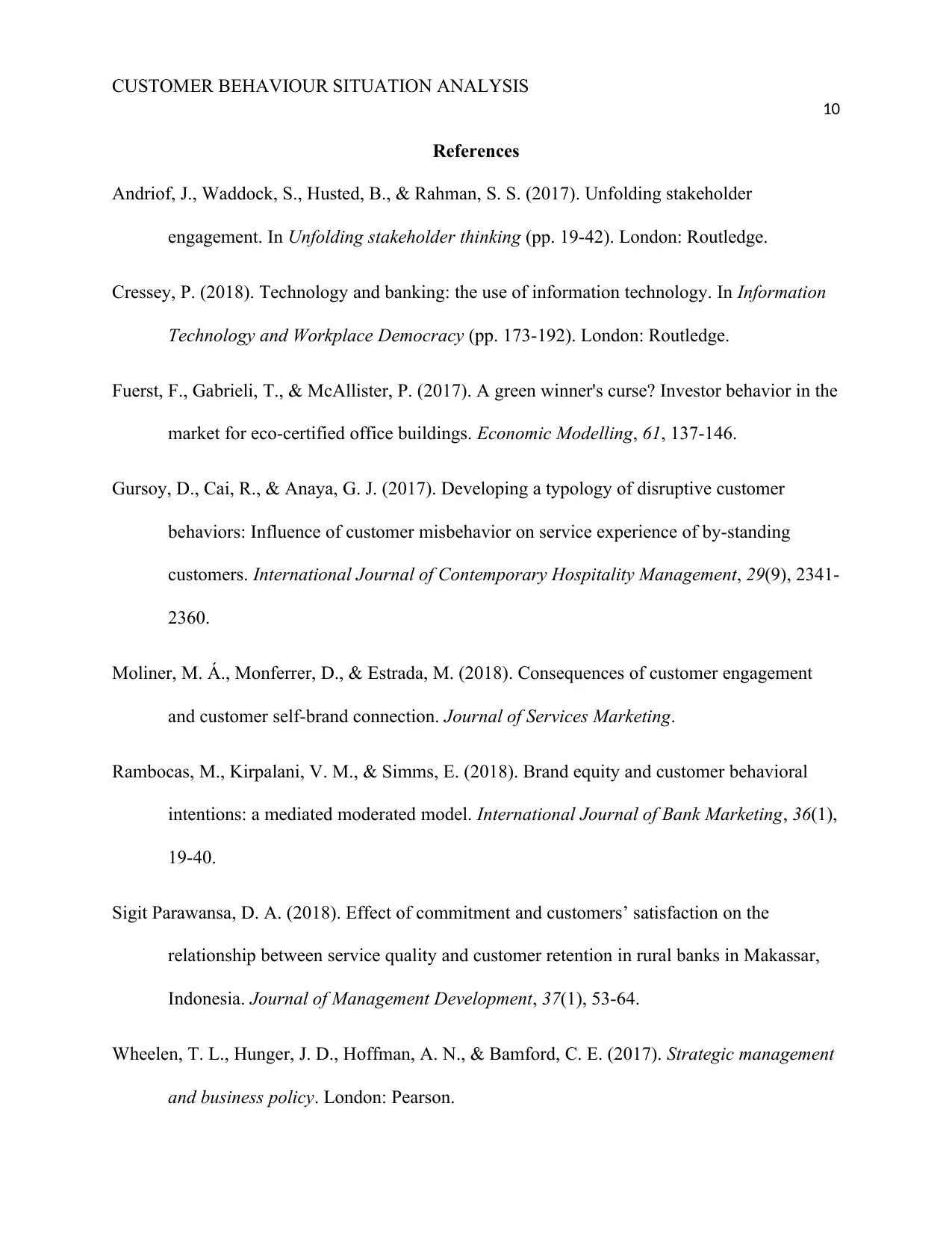
CUSTOMER BEHAVIOUR SITUATION ANALYSIS
10
References
Andriof, J., Waddock, S., Husted, B., & Rahman, S. S. (2017). Unfolding stakeholder
engagement. In Unfolding stakeholder thinking (pp. 19-42). London: Routledge.
Cressey, P. (2018). Technology and banking: the use of information technology. In Information
Technology and Workplace Democracy (pp. 173-192). London: Routledge.
Fuerst, F., Gabrieli, T., & McAllister, P. (2017). A green winner's curse? Investor behavior in the
market for eco-certified office buildings. Economic Modelling, 61, 137-146.
Gursoy, D., Cai, R., & Anaya, G. J. (2017). Developing a typology of disruptive customer
behaviors: Influence of customer misbehavior on service experience of by-standing
customers. International Journal of Contemporary Hospitality Management, 29(9), 2341-
2360.
Moliner, M. Á., Monferrer, D., & Estrada, M. (2018). Consequences of customer engagement
and customer self-brand connection. Journal of Services Marketing.
Rambocas, M., Kirpalani, V. M., & Simms, E. (2018). Brand equity and customer behavioral
intentions: a mediated moderated model. International Journal of Bank Marketing, 36(1),
19-40.
Sigit Parawansa, D. A. (2018). Effect of commitment and customers’ satisfaction on the
relationship between service quality and customer retention in rural banks in Makassar,
Indonesia. Journal of Management Development, 37(1), 53-64.
Wheelen, T. L., Hunger, J. D., Hoffman, A. N., & Bamford, C. E. (2017). Strategic management
and business policy. London: Pearson.
10
References
Andriof, J., Waddock, S., Husted, B., & Rahman, S. S. (2017). Unfolding stakeholder
engagement. In Unfolding stakeholder thinking (pp. 19-42). London: Routledge.
Cressey, P. (2018). Technology and banking: the use of information technology. In Information
Technology and Workplace Democracy (pp. 173-192). London: Routledge.
Fuerst, F., Gabrieli, T., & McAllister, P. (2017). A green winner's curse? Investor behavior in the
market for eco-certified office buildings. Economic Modelling, 61, 137-146.
Gursoy, D., Cai, R., & Anaya, G. J. (2017). Developing a typology of disruptive customer
behaviors: Influence of customer misbehavior on service experience of by-standing
customers. International Journal of Contemporary Hospitality Management, 29(9), 2341-
2360.
Moliner, M. Á., Monferrer, D., & Estrada, M. (2018). Consequences of customer engagement
and customer self-brand connection. Journal of Services Marketing.
Rambocas, M., Kirpalani, V. M., & Simms, E. (2018). Brand equity and customer behavioral
intentions: a mediated moderated model. International Journal of Bank Marketing, 36(1),
19-40.
Sigit Parawansa, D. A. (2018). Effect of commitment and customers’ satisfaction on the
relationship between service quality and customer retention in rural banks in Makassar,
Indonesia. Journal of Management Development, 37(1), 53-64.
Wheelen, T. L., Hunger, J. D., Hoffman, A. N., & Bamford, C. E. (2017). Strategic management
and business policy. London: Pearson.
1 out of 10
Related Documents
Your All-in-One AI-Powered Toolkit for Academic Success.
+13062052269
info@desklib.com
Available 24*7 on WhatsApp / Email
![[object Object]](/_next/static/media/star-bottom.7253800d.svg)
Unlock your academic potential
Copyright © 2020–2025 A2Z Services. All Rights Reserved. Developed and managed by ZUCOL.





